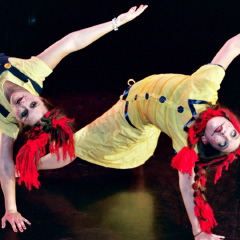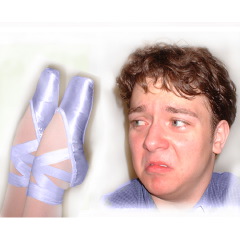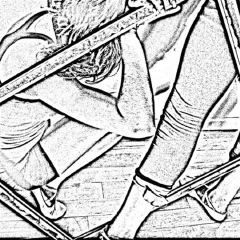Fringe Shorts: Lightsey Darst
Read on for ongoing Fringe coverage from Lightsey Darst. Check back for new reviews of dance-related Fringe daily.





Wait. . . I Think My Eyes Were Closed
Shelby Hayhoe, Jill Peterson, and Jeff Mason have created something strange in Wait. . . I Think My Eyes Were Closed. The title must be a wink at the intense ordinariness of this show, which invokes the word “circus” in its program description: there are no tricks here to miss, unless you count one low but not freakish limbo. Not even the “plots” of the individual dances include the drama one expects—no love stories, no rage, no depression.
Instead we get four women winding themselves around in a long silk or a lot of people slewing around the stage unemotionally like stagehands run amuck. The most dramatic piece features four women in bright dresses running after four people in black who are all carrying blank newspapers; the climax comes when the four women at last get a newspaper, discover its emptiness, and shred it. What? Trust me, it isn’t an allegory for illiteracy.
Not that “Wait” is dull. Hayhoe, Peterson, and Mason have a great sense for stage space and for rhythm, and the result is mesmerizing—and soothing to the frantic Fringe-goer. I’d compare “Wait” to a really good screen-saver if that didn’t seem insulting, because this show has the same endless watchability, even as nothing in particular is happening. The trick is that this nothing is so purposeful and so pleasingly on the zippy soundtrack that it’s like another world—not a pallid version of this one.
The creators are helped out by the insouciant confidence of most of their performers. Almost all of them look sure of their moves and happy to be on stage—which makes us happy to be in the audience watching them.
Choreography by Shelby Hayhoe, Jill Peterson, and Jeff Mason,
at the Southern Theater, August 11 at 8:30
That Which Binds Us: Rural Route Dance
My feelings about “That Which Binds Us,” by Rural Route Dance, varied from one piece to the next. I cringed at “Family Is,” a schmaltzy composition exercise retailed as a composition, but then two solos (or near-solos—a prone child featured in one) went pleasantly by, and both dancers (Shannon Edwards and an unidentified understudy) showed strength and skill; then came a yoga-inspired mishmash that had me shifting around in my not-air-conditioned seat; and then “Widow’s Song” provided a meditative, moving, unexpected finish. (Throughout, I enjoyed C. J. Mulder’s songs, performed by himself and Jessica Crary live. Why don’t more dance Fringe shows manage live music?)
Rural Route Dance is the creation of Nora Bichler and Carla Bode, two Mankato State grads who are now dance specialists in two exurban middle schools. I’ve never been to Mankato, or to the places where these choreographers teach: what dance comes out of these flyover lands in a flyover state? Weighted yet smooth-lined modern, fairly simple musically-motivated compositions—nothing fancy, and truthfully, Rural Route Dance is more in the realm of craft than art—yet it’s marvelous that among the crafts being practiced in Anoka and Buffalo, among the pies, preserves, and seed art, is this modern dance.
Things have changed. When I went to middle school we had two awful weeks of square dance and, when the gym teachers got tired of seeing us bounce volleyballs off each others’ heads, a few blissful days of the Bus Stop—but no dance specialists. Modern dance is mainstream now, its gifts of free movement and bodily confidence being brought everywhere by apostles like Bichler and Bode. This is good work that they do.
At Patrick’s Cabaret, 3010 Minnehaha Ave S
Minneapolis, produced by Carla Bode & Nora Bichler Dance Collective
from Dassel, MN; August 10 at 7 PM and August 11 at 10 PM.
Conundrum: Staggering Through the Chestnuts
If you absolutely must find a creditable version of the four little swans from Swan Lake in this year’s Fringe, “Conundrum” is your show. This dance-theater piece, directed by Joseph Bingham, relies on a very simple premise: mix up different dance and theater genres, each competing with each other.
Thus the rest of the cast heckles as one member attempts to stagger through “Memory” from Cats; the four little swans are interrupted by one goofy big swan and four duck-hunters; Grease is cut off by everything from Fiddler on the Roof to MC Hammer. What’s more, it’s all performed pretty well, and a few pleasant dance pieces are allowed to run without interruption. Since dance is this largely Continental Ballet Company cast’s strength, this is a good thing.
Oddly, “Conundrum” is really about a 20- or 30-minute show, eked out with a guest appearance from another Fringe show and a lot of that outsize gay diva comedy that I find cringe-worthy but that seems to entertain most audiences. If this weren’t Fringe, the hodge-podge would be a problem. But as it is, who cares?
For most Fringe-goers, “Conundrum” is the perfect dance-theater piece: talented young people performing slightly tweaked but basically familiar bits and pieces, all carried off with good humor.
At the Ritz theater, 345 13th Ave NE,
Minneapolis, August 10 at 4 PM and August 11 at 8:30 PM.
We’ll Survive If We Don’t Protect Ourselves
Penelope Freeh wins the “Which of these things is not like the others?” award with her Fringe show, “We’ll Survive If We Don’t Protect Ourselves”.
While a good chunk of the Fringe soaks in “Hey, kids, let’s put on a show!” amateurism, Freeh spins an hour of intense dance that asks no indulgence from the audience. Freeh’s modern ballet is prickly as baroque music, detailed as crazy quilts, and smart in every flick of the wrist. Hurtle, thrash, stop/start of momentum, breakneck dash as long as the space allows, and then the slow elaboration of a hand: Freeh choreographs as if movement were the only way to project a self into the world.
And the need to make oneself felt is desperate, and met: take the second when, after a rush of catch-and-lose partnering, Nicholas Lincoln holds over Christine Maginnis while something grows in her animal eyes—and then her back arches, sweet spasm, and they’re off again. Freeh excels at rapid invention in this quartet, but she can slow herself to dream paces: Maginnis again, this time held by Eric Boone on the upper balcony of the atrium, beautifully losing her footing over and over.
But “We’ll Survive” is more than Fringe riches: it’s a step forward for Freeh. In the past her work’s revolved around binary conflicts: self vs. other, self vs. world. There’s nothing small about self vs. world, but the falsity of a few nostalgic moves in this work—gestures of constriction and defense—reveals the new air Freeh’s breathing. “We’ll Survive” is not a closed gemstone like many of her earlier works; it’s looser, less defined, and offers a thousand entrances. Some of Freeh’s risks feel like dares (take the gorilla heads), but when an artist as sharp as Freeh begins to dare, look out.
The opening night audience, mostly not a dance crowd, gave Freeh’s work and her excellent dancers a standing ovation, thus proving that however intellectual its roots, the real thing gives a visceral kick that anyone can feel.
August 9, 10, 11, 12, all at 7 PM,
at the Grain Belt Bottling House Atrium, 79 13th Ave NE
Minneapolis. Tickets: (651) 209-6799 or www.uptowntix.com
Making Dolls
By Rainy Day Cabaret, with choreography by Joanie Mix
It’s hard to make sense of the soup of ingredients in “Making Dolls”: athletic modern dance performed by strong, long-lined young women (think handstand splits and big curvy jumps); a soundtrack mixing techno beats with such depressive favorites as Tori Amos and Nine Inch Nails; and a story of costume-induced possession (i.e., you put on the dress, you go crazy), most of it told through film.
I kept wondering, where is this Coppelia/music video/Sylvia Plath suicide love/dress-up paper doll thing coming from? In fact, I got so caught up in the question “What is the gloom of college-age women?” that I viewed the stage action as sociological evidence rather than artistic creation.
As artistic creation, “Making Dolls” is a student effort, which is appropriate, given the just-past-college age of choreographer Joanie Mix and her company. The show is oddly shaped, with what seems like the beginning halfway in and an extended ending which puts the audience in the awkward position of clapping for ten minutes. Context is absent, so that it’s hard to tell whether this “what they want you to wear will destroy you” scenario is meant as sci-fi, horror, or cultural critique. Dance and film aren’t integrated, although the film is ambitious and professionally smooth.
More interesting than any craft or lack thereof, though, is the driving idea. Mix has tapped some deep anger about the rules of feminine self-presentation, the pretty and toothless sex appeal that young women now are expected to put forward into the world, even as they feel themselves to be dangerous, sharp-edged, and full of unknown powers. This is the first feminist jab I’ve seen from the younger generation of women, a generation that’s often seemed perfectly happy in its baby doll dresses, and I’m transfixed. Lolita speaks: what does she have to say?
August 8 at Intermedia Arts at 10 PM, August 11 at 8:30 PM, 2822 Lyndale Ave S, Minneapolis. Tickets: (651) 209-6799 or www.uptowntix.com